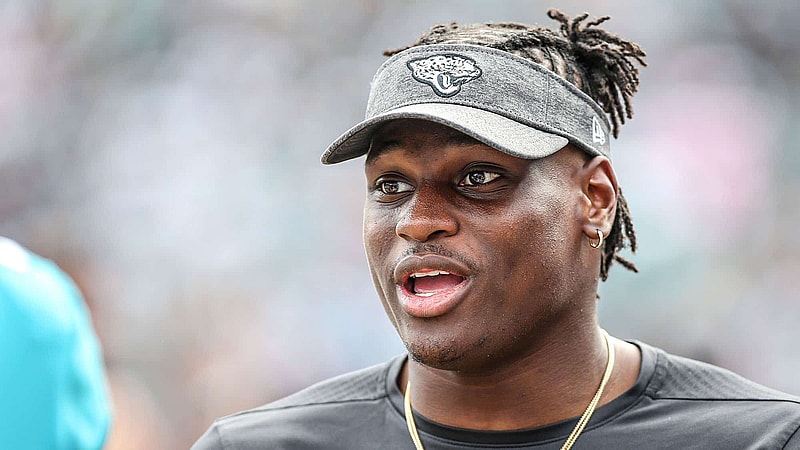Quincy Williams brings potential and a load of question marks to the New York Jets
The New York Jets claimed two players off of waivers on Wednesday – defensive end Tim Ward and linebacker Quincy Williams.
Quinnen Williams‘ older brother by 16 months (recently turning 25), Quincy was unable to find his footing in Jacksonville after being taken in the third round of the 2019 draft out of Murray State. He missed nine of his first 20 career games due to injury and struggled when healthy, eventually getting relegated to the bench for the majority of his second season.
Could Williams turn his career around in New York? Let’s dig into some of the most notable aspects of his player profile.
Athletic profile
Williams’ athletic profile is a mixed bag. He is elite in some areas but weak in others.
Here are a few of Williams’ Murray State pro day numbers and their Relative Athletic Score (RAS) – a 0-to-10 score that summarizes how the number compares to a player’s peers at his position all-time.
- Vertical jump: 39.5 inches (9.8)
- Broad jump: 124 inches (9.3)
- 20-yard split: 2.64 seconds (9.3)
- 40-yard dash: 4.59 seconds (9.0)
- 10-yard split: 1.62 seconds (7.8)
- 3-cone drill: 7.25 seconds (4.6)
- Short shuttle: 4.41 seconds (4.2)
- Bench press: 17 reps (2.7)
- Weight: 225 pounds (1.7)
- Height: 5 feet, 10.6 inches (0.4)
Williams showcased great speed and explosiveness but a problematic lack of size and strength.
Usage, role, and playing time
Williams started eight of his 11 appearances as a rookie, primarily playing middle linebacker and weakside (Will) linebacker in Jacksonville’s 4-3 defense.
In his average game, Williams played 69% of the Jaguars’ defensive snaps. His role fluctuated wildly throughout the year – he played every snap in three games and zero snaps in two games.
Williams’ role was minimized in his second season. After missing the first four games of the season, he mainly played on special teams over his first two games back.
An injury to starting linebacker Dakota Allen thrust Williams into the lineup for 96% of the defensive snaps in his third game, coming against the Chargers. Williams played poorly (3 missed tackles) and would not get another defensive snap over his ensuing four appearances throughout the season.
The Jaguars did not use Williams as a blitzer too often. He rushed the quarterback on 6.2% of his defensive snaps in Jacksonville. The 2020 NFL average for linebackers was 8.7%.
Get Started: Learn More About Becoming A Jet X Member
Missed tackles are an enormous problem
Those three missed tackles against the Chargers were a representation of the main problem that has plagued Williams throughout his short career.
Williams failed to convert 23.3% of his tackle opportunities from 2019-20. That was the worst rate among linebackers to play at least 500 snaps over that span.
Coverage upside is merely hypothetical for now
Williams’ speed suggests he could become a good player in coverage.
For now, that remains a projection, as we have not seen it from him on the field yet.
Over 42 targets thrown his way, Williams has recorded zero interceptions and one pass breakup. He has given up 412 yards on throws in his direction, an average of 9.8 per target (2020 LB average: 7.3).
To his credit, Williams has yet to allow a touchdown. He also has yet to commit a penalty in his career (during the regular season – he had one in this year’s preseason).
Run defense is also an issue
Williams has a poor Pro Football Focus run defense grade of 48.5 over his two seasons. He is not an active playmaker in that phase. With nine run stops over 180 snaps against the run in 2019, his run stop rate of 5.0% ranked at the 15th percentile among qualified linebackers.
Can he at least blitz?
Well, unfortunately … no. Williams has not done much as a pass rusher, either.
Williams has recorded four pressures over 36 career pass-rush snaps, a pressure rate of 11.1% that is below the 2020 linebacker average of 14.3%.
All four of those pressures were hurries – none were sacks or hits. Williams’ 46.6 pass-rush grade at PFF in 2019 was the worst among 72 qualified linebackers.
2021 preseason recap
Williams played in all three of Jacksonville’s preseason games, logging 66 snaps.
There wasn’t much to write home about in either a positive or negative way. Williams made seven tackles but missed one (12.5% miss rate). He allowed only 29 yards over six targets (4.8 per target) but also had a roughing the passer penalty. While he did not record any pressures over 11 pass-rush snaps, he had one batted pass.
Conclusions
Bringing in Williams is entirely an upside play by the Jets. He has not put forth intriguing production in any facet of the game throughout his limited professional action.






